Oklahoma! at The Peace Center
Bruce Steele: The Broadway touring production of Oklahoma! now at Greenville, South Carolina's Peace Center is not the show fans of the movie are likely to expect. How would you summarize this thoroughly current staging of the 1943 Rogers and Hammerstein classic?
Edwin Arnaudin: The phrase “not your grandmother’s Oklahoma!” has been tossed around in regard to director Daniel Fish’s interpretation, and I concur. While some of the updates prove more successful than others, I admire their provocative nature and had a twisted grin beneath my mask as people around me fidgeted throughout the first act, some leaving empty seats after intermission. The experience reminded me that art is sometimes meant to shock — and that certain theatergoers clearly aren’t ready for that.
Bruce: There were shocking moments, indeed. That's to be expected in a production that seems to represent a younger generation grappling with the undercurrents of an iconic show, including sex shaming, suicide, social ostracising, gender inequality, and more. It's not a happy show, which theatergoers should know going in. Set on a nearly bare stage with just some picnic tables and chairs, this Oklahoma! is largely stripped of dance numbers, and many of its joyful songs become more questions than assertions — starting with Curly's "Oh, What a Beautiful Mornin'." But — is it, really?
Edwin: Even with the unusually sparse set, which includes a wall of gun racks, there’s still a good amount of positivity in the first act. Having Curly (Sean Grandillo) strum an acoustic guitar while singing adds a particular brightness to the opener and other tunes, especially when he hops on the mic with the onstage country/bluegrass band/orchestra. His flirtations with Laurey (Sasha Hutchings) also remain fun and funny, and the combo of Ado Annie (Sis) and Will (Hennessy Winkler) provide extra comic relief.
Bruce: Of course you're right — the show is not joyless, but it's much more subdued than previous Oklahoma!s. With Aunt Eller (Barbara Walsh) relegated to nearly uninflected line readings from a chair or standing to one side, most of the sustained humor comes, not surprisingly, from Ado Annie. Sis's portrayal is boisterous and powerful, as if to let Ado Annie reclaim her sexuality, and Fish even gives her an encore for "I Cain't Say No," played directly to the enthusiastic audience, and complete with mic drop. Many of her later scenes also perk up the proceedings. But there are aspects of the show that seem intentionally off-putting.
(Review continues below the photo. Please scroll down!)
Sasha Hutchings as Laurey and Sean Grandillo as Curly in Oklahoma! Top photo: The cast performs the show’s one remaining ensemble dance number, “The Cowboy and the Rancher.”
Edwin: Where Fish starts to lose me is when he cuts the lights for the tense smokehouse exchange between Curly and Jud (Christopher Bannow), forcing the audience to imagine the salacious photos on Jud’s wall, yet interrupting the show’s flow. A later employment of darkness is similarly jarring, and not necessarily in a good way. The use of a cameraman projecting Jud’s face on the back wall during “Pore Jud is Daid” to augment the hired hand’s humanity as Curly sings of his rival's demise is another odd choice with uneven results. There and elsewhere, Fish transforms Oklahoma! into more of a drama than a musical, and while his ensemble often rises to the occasion, his commitment to a consistent, darker message wavers, leading to confusion rather than shock.
Bruce: Well, the show is the show, so some songs push back against Fish's attempt to thoroughly deconstruct it. I wasn't sure what he was up to during Act I, but as soon as Act II started, Fish pushes his priorities into the audience's faces. It's a kind of make-or-break moment. The show's dream ballet, usually the Act I closer, is here jettisoned and replaced with a modern, sensual, provocative solo dance to dissonant music that I will leave theatergoers to discover for themselves. But that's when I said to myself, "Ah. This is as much a show ABOUT Oklahoma! as it is a version of the show itself." The dance is confrontational — I think in a good way — and representative of all the cultural subtext the show usually glosses over. It did drive some audience members to give up and head for the exits, but to me that just meant that it was working. Then, relevant to your point about tonal inconsistencies, the cast returns in frilly skirts and chaps to dance to an upbeat, fairly traditional "The Cowman and the Ranger." It sort of leaves you with a feeling of, "What just happened?"
Edwin: Agreed. Much as I think I’d like a complete overhaul, I enjoyed the faithful renditions of the famous songs, though the full-ensemble reprise of the titular number carries such an acidic edge that it seemed like the cast — Hutchings especially — wanted to fight some attendees. Even before that caustic finale, Fish’s production gives audiences plenty to process, including a blunt handling of violence and its aftermath that reminded me of bystanders’ inaction to white law enforcement officers suffocating unarmed Black men. If you want a warm, safe, familiar Oklahoma!, you’ll only find it here in bits and pieces. But if you’re open to being challenged while still being rewarded with plenty of humor and toe-tapping Broadway standards, get your tickets now.
Oklahoma! runs through November 21 at the Peace Center. For details and tickets, visit peacecenter.org.
(Photos by Matt Murphy/MurphyMade, courtesy of the Peace Center)





